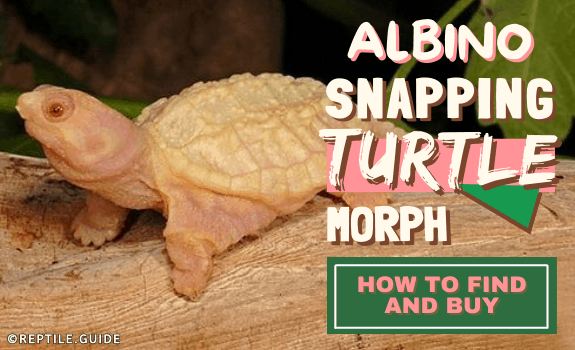Prepare to be amazed by albino snapping turtles. These turtles are massive and look like white, red-eyed dinosaurs!
Learn all about these exciting anomalies – and how to buy one.
Top image by The Turtle Source via Pinterest.
In This Article
In Short
- In captivity, ‘snapping turtle’ refers primarily to the Common Snapping Turtle (CST) or the Alligator Snapping Turtle (AST).
- There are limited reports of possible albino ASTs in captivity.
- Some reptile breeders focus on producing albino CSTs, but they’re still challenging to find – and expensive to purchase.
- Caring for an albino snapper is the same as caring for a wild-type snapper. The primary difference is lighting – albino animals are more sensitive, so hiding spots are imperative.
What Is An Albino Snapping Turtle?
An albino snapping turtle is, first and foremost, a snapping turtle.
That term usually refers to one of two North American turtle species.
The common snapping turtle (Chelydra serpentina), or CST, inhabits most of the western United States and southeastern Canada.
They’re famous for thriving in cold environments.
The alligator snapping turtle (Macrochelys temminckii), or AST, inhabits a small range in the southeastern United States, including Florida and Georgia.
They’re massive and look eerily prehistoric.
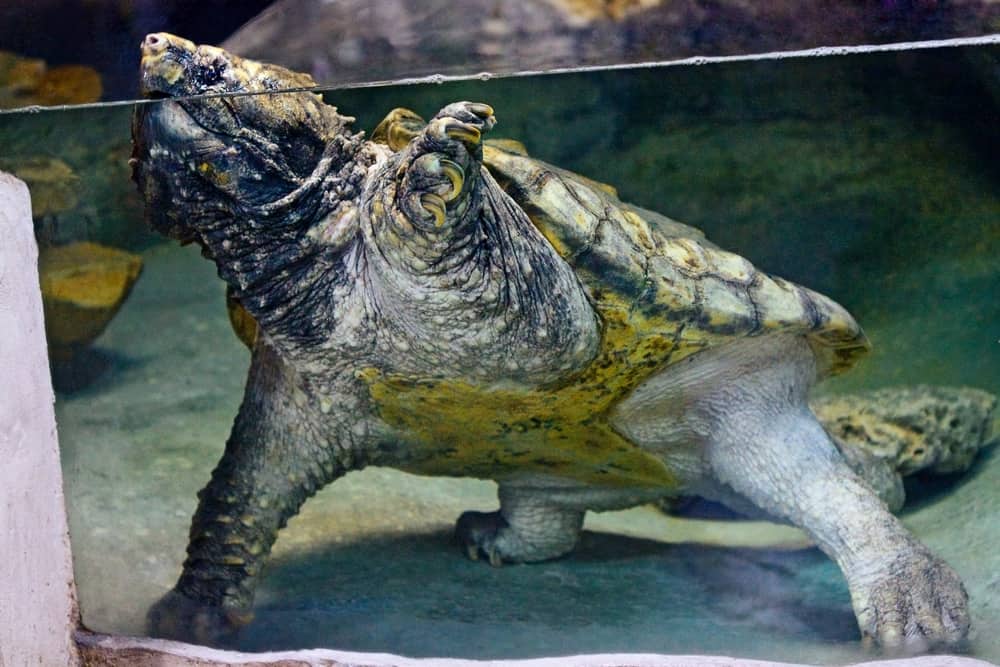
There are some other, less popular snapping turtle species, too:
- South American Snapping Turtle (Chelydra acutirostris)
- Central American Snapping Turtle (Chelydra rossignonii)
- Suwannee Snapping Turtle (Macrochelys suwanniensis)
- Apalachicola Snapping Turtle (Macrochelys apalachicolae)
“Albino” is the common term for “amelanistic“. Amelanistic means that the animal lacks melanin – the pigment that creates black and other dark colors.
Albino snapping turtles are unlikely to survive in the wild because they lack natural camouflaging abilities.
As quarter-sized hatchlings, they’re easily spotted and eaten by their numerous natural predators, including:
- Foxes
- Coyotes
- Raccoons
- Opossums
- Birds of prey
On the off chance that they do make it, they still stick out like a sore thumb to their food sources.
Despite being ambush predators, albino snappers cannot simply ‘sit and wait‘ for prey to pass.
Prey animals, like small fish and amphibians, will easily see them and avoid them like the plague!
Any albino animal has very little chance of survival in the wilderness.
Albino snapping turtles in captivity may be either Chelydra serpentina or Macrochelys temminckii.
They’re likely captive-bred, but could also originate from eggs harvested from the wild.
Albino Alligator Snapping Turtle
Albino ASTs are extremely rare, special animals. You’d likely have to search for years to find one.
A male alligator snapper is typically larger than a female, reaching two feet long and 250 pounds.
They resemble a standard wild-type alligator snapping turtle, including these defining characteristics:
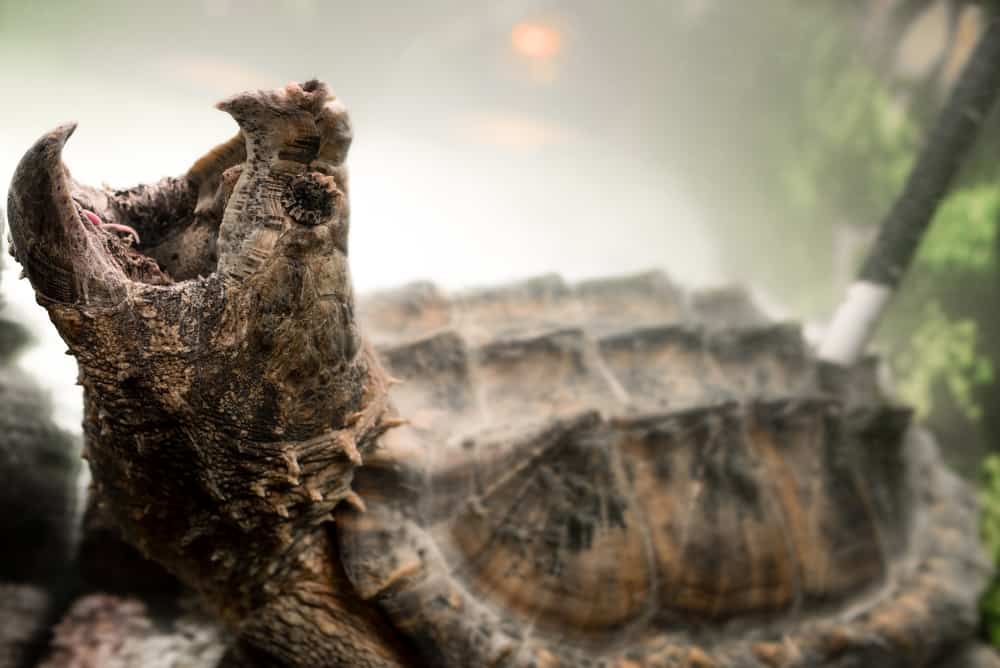
- Large, hooked beak
- Rough, bumpy shell
- Triangular, pointy head
- Three keeled ridges on carapace
- Fleshy ‘eyelash-like’ growths around eyes
- Red, fleshy worm-like lure inside the mouth
The only difference is their coloration.
The only information regarding an albino alligator snapping turtle in captivity is linked to an exporter in Singapore.
Albino Common Snapping Turtle
Albino CSTs are more common than albino ASTs. Still, they’re pretty rare and exotic.
A male CST is typically larger than a female, reaching 18 inches long and 75 pounds.
Like regular common snapping turtles, they’re easy to identify by their:
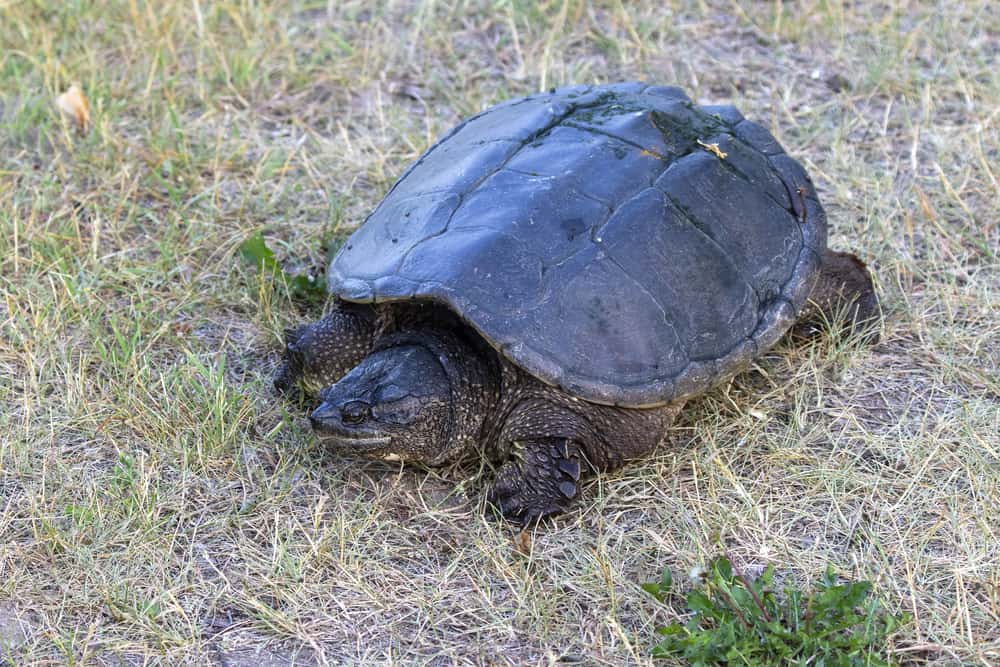
- Oval head
- Smooth shell
- Rounded beak
- Smaller size (max 20 in, 75 lb)
If you’re hoping to find and buy a pet albino snapping turtle, the albino CST is the way to go!
What Do Albino Snapping Turtles Look Like?
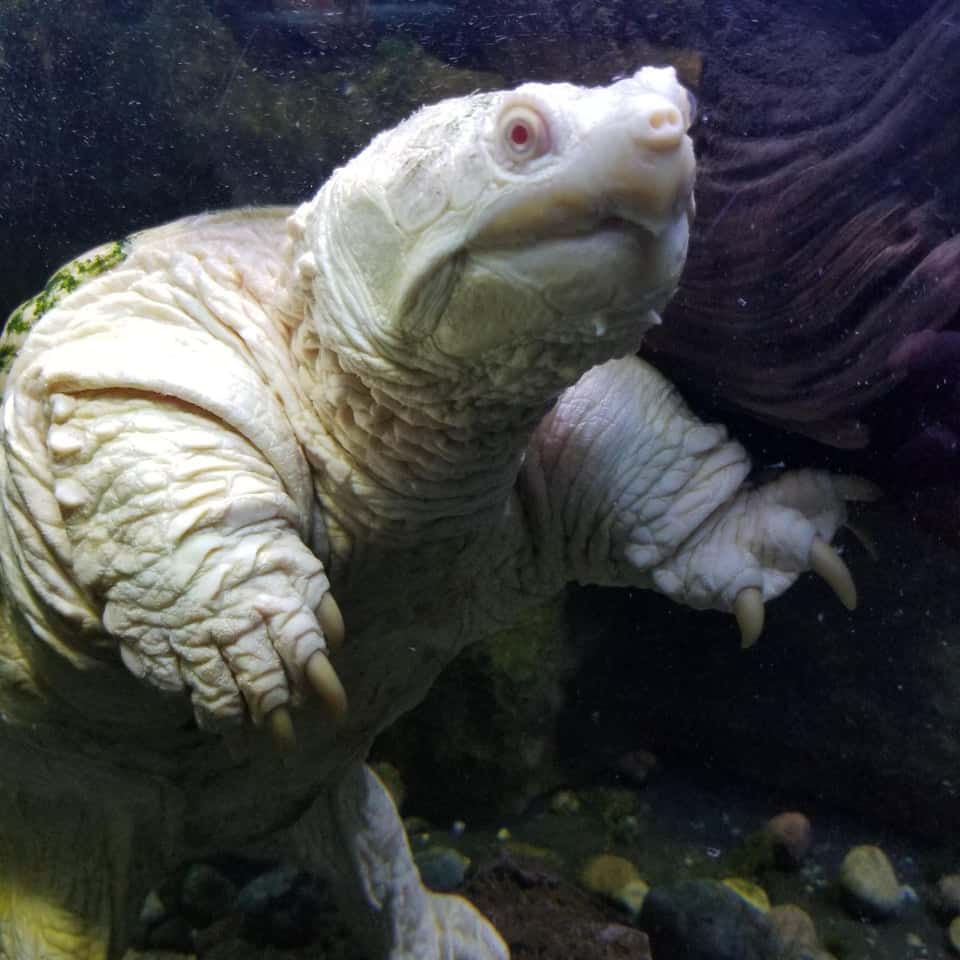
In terms of body shape and defining characteristics, an albino snapping turtle looks just like its wild-type counterpart.
Instead of the typical dark brown, gray, or black coloration – albino snappers range from pink (hatchlings) to yellowish-white (adults).
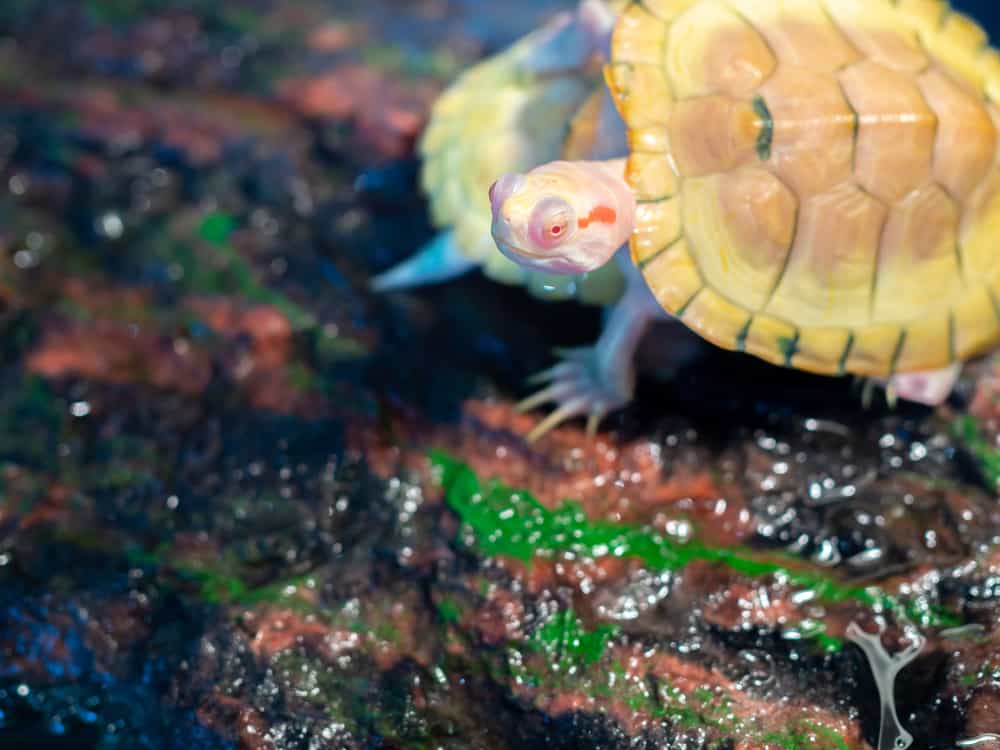
If an albino snapping turtle survived long enough in the wild, its shell might grow dark-green algae.
This growth would take time, but it would help the turtle camouflage and survive.
Albino animals’ eyes are also affected. Where regular snapping turtles have dark eyes, an albino snapping turtle has red or pink eyes!
Albino Snapping Turtles vs. Normal Snapping Turtles Care
In terms of captive husbandry, there is little difference between wild-type snappers and albino snappers (or any other morph, for that matter!)
Here are the basics:
Adult Minimum Enclosure Dimensions: 3’ x 2’ x 1.5’ (1 x 0.5 x 0.5 meters)
Lighting Cycle: 12 Hours On/12 Hours Off
Ideal Daytime Basking Temperature: 80-85°F (26.7-29.4°C)
Ideal Water Temperature: 75-78°F (23.9-25.6°C)
Ensure that your turtle’s enclosure has a tight-fitting lid.
The bottom should be bare, or you can use sand or large river rocks. Never use gravel that your turtle can ingest.
You’ll need a strong filter – the strongest filter you can find! External canister filters are best.
Include several hiding opportunities, like logs, PVC pipes, or caves. These are especially important if you’re using UVB lighting for your albino turtle.
Albino animals are particularly susceptible to the harmful effects of UV rays.
Still, they likely require UVB to synthesize vitamin D3 and calcium. Just ensure they have the opportunity to shade themselves as needed.
Feed your albino snappers a dietary mix of approximately 70% protein-based food:
- Mice
- Snails
- Crickets
- Crayfish
- Frog legs
- Turtle pellets
- Frozen fish filets
- Live feeder fish (avoid goldfish and minnows)
- Live earthworms and nightcrawlers (avoid bait worms)
and 30% plant-based food:
- Duckweed
- Water lettuce
- Leafy greens
- Water hyacinth
Baby turtles should eat as often as every day, while adults are healthiest when they eat two to three times a week.
Change 25% of the water in the aquarium every week.
Be sure to use a turtle-safe aquarium water conditioner, and test your pH, ammonia, nitrites, and nitrates often – at least once a month.
And as with ordinary snapping turtles, you need to be very cautious with how you pick up your albino friend.
Where to Find Albino Snapping Turtles For Sale
Even albino CSTs are challenging to find! Albino ASTs are virtually non-existent in captivity.
Two online reptile retailers, Reptiles ‘N Critters and Backwater Reptiles, appear to offer albino snapping turtles for sale occasionally.
Still, it seems that they go out of stock quite often.
If you’re determined to own an albino snapper, try to search turtle classifieds on Morph Market, Kingsnake.com, and Fauna Classifieds. You might just get lucky!
If you’re feeling impatient for your unique turtle, consider purchasing a hypo CST, instead!
They’re much more readily available, cheaper, and some may even say prettier.
How Much Does an Albino Snapping Turtle Cost?
Albino CSTs are expensive.
An albino baby snapping turtle, which tends to be cheaper than an adult, still fetches a price of roughly $4,500!
In comparison, captive-bred wild-type snapping turtles cost as little as $20.
And that’s despite the fact that snapping turtle eggs can hatch up to 180 days after they’re first laid.
Furthermore, the cost of caring for a giant adult snapping turtle is astronomically higher than caring for a smaller pet turtle.
Other Snapping Turtle Morphs
Did you know that albino isn’t the only snapping turtle morph?
While they may not have as many morphs as ball pythons or leopard geckos, there are several other interesting snapping turtle oddities – in the wild and captivity.
Leucistic Snapping Turtle
In 2008, an Illinois resident found a leucistic CST on the road. He brought it home and called in a state wildlife official, who confirmed his suspicion.
However, they don’t have red eyes. Their eyes may be black, blue, or any other natural color.
Leucistic snapping turtles don’t seem to pop up in the pet trade.
Hypo Snapping Turtle
Hypo snapping turtles are relatively common in captivity. They’re also rather affordable – you could buy one for as little as $175!
“Hypo” is a shortened term for hypomelanistic. Rather than lacking all melanin, they have reduced melanin.
Hypo snapping turtles are born with yellowish-tan skin and a brown shell. As they mature, their skin turns pink or cream-colored.
Piebald Snapping Turtle
Biologists believe that a “piebald” appearance is caused by partial leucism.
For unknown reasons, only certain parts of the body lack pigmentation – while other parts are colored normally.
This mutation results in a turtle that has patches of white on an otherwise wild-type body and shell.
There are numerous reports and accounts of piebald snapper sightings but limited photo evidence.
Snapping Turtle Hybrids
Despite being different species – and completely different genera – at least one private keeper reports that he successfully cross-bred an AST to a CST.
Multiple videos reportedly showcase this strange AST x CST combination.
While it’s difficult to prove, these specimens seem to fit the bill according to turtle experts:
- Hooked bill (AST trait)
- Rounded head (CST trait)
- No tongue lure (CST trait)
- Ridged carapace (AST trait)
If you’re interested in other underwater albino friends, we recommend checking out the albino axolotl!
What is your favorite snapping turtle morph? Let us know in the comment section.
